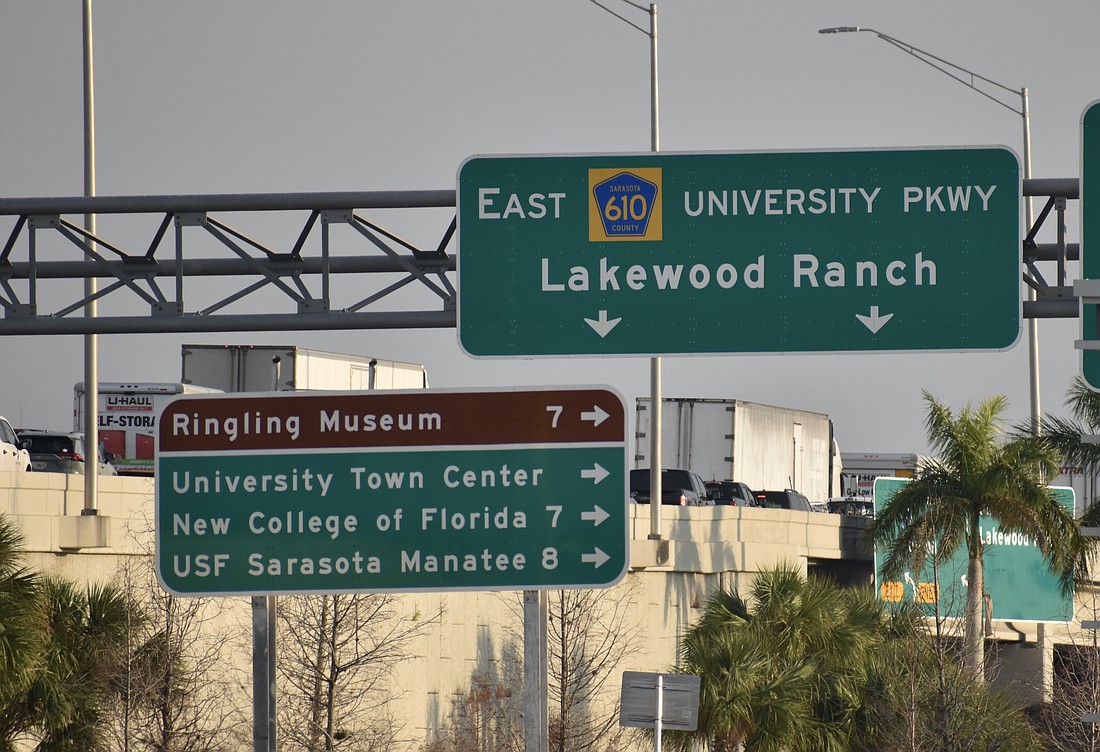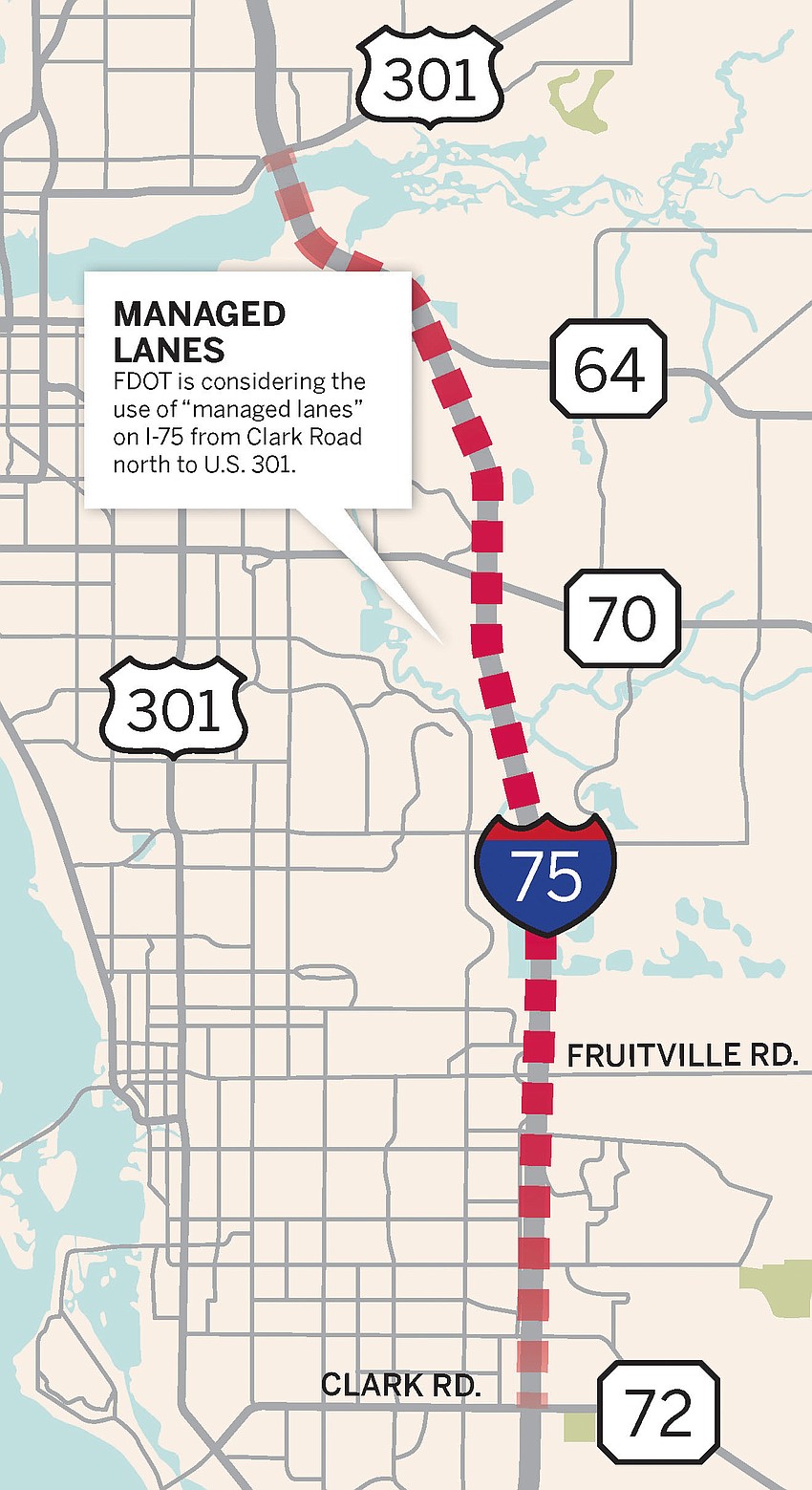- May 19, 2025
-
-
Loading

Loading

Would you be willing to pay extra for a faster trip on Interstate 75?
That was one of the questions that emerged at a Florida Department of Transportation open house Feb. 23 at the Realtor Association of Sarasota and Manatee in Sarasota.
The open house was held to get feedback from the public about the FDOT’s Interstate 75 corridor master plan from River Road in Sarasota to Moccasin Wallow Road in Manatee County.
Among the topics discussed were “managed lanes,” which would be lanes that would run parallel to the left of the regular I-75 lanes from Clark Road in Sarasota County to U.S. 301 in Manatee County, and likely would be separated by a concrete barrier or some other type of barrier.
Those “managed lanes” could be toll lanes that might have restrictions, such as not allowing semi trucks. “Managed lanes” are becoming more common in Florida, such as the Lee Roy Selmon Expressway in Tampa. The toll system could be entirely electronically controlled, utilizing a SunPass or a license-plate reader.
Joshua Jester, the FDOT’s project manager for the master plan for I-75 in the region, said the feasibility of adding tolled lanes will continue through the planning process. However, the current traffic analysis has been conducted using the assumption that the roads would not be tolled.
The discussion was all part of the open house in which the public offered suggestions and comments.
“We want people to be giving all the comments they can — the good, the bad, the ugly ... whatever it is,” Jester said.
Besides talking about “managed lanes,” the FDOT noted that five major interchange improvement projects on that stretch of road are planned. Five other highway improvement projects also were planned.
“I’m glad they’re having this,” said Sarasota’s Jon Prettyman, who attended the open house. “Instead of saying, ‘This is what we’re giving you,’ they’re saying, ‘Here’s what we’re thinking about.’”
Jester said the purpose of the plan is to accommodate future growth, with roads in the region having already outpaced the capacity limits indicated by the most recent studies in 2012.
Jester said current studies indicate population will continue to grow rapidly.
The creation of the plan involved data collection, public outreach, analysis of current and future transportation needs and identification and evaluation of potential projects.
Jester said the plan, which is set to be finalized by August, is targeting a 2045 or sooner date for completion in its entirety.
However, the FDOT wants to break down the plan into a steady stream of small projects.
“We don’t want a $2 billion project,” Jester said. “Part of our master plan is identifying smaller projects to advance through our project development phase.”
Jester said priority projects will be established based on feedback from the public, transportation officials, elected officials and first responders.
“I can tell you that (feedback) can significantly change (priorities),” said Jester, who said early feedback was vital to the process. “But I can’t tell you how we’re going to change it.”
The “managed lanes” would be like adding a parallel roadway and would serve those who planned on making longer-distance trips than anyone doing local business.

To accommodate the strategy, the FDOT has made previous improvements with the knowledge it might need additional land to the left of both its northbound and southbound lanes of I-75.
Recent interchange projects in the area, such as the project at University Parkway, involved moving the north and south bridges farther apart in anticipation of future “managed lanes,” he said.
“We’ve been working toward this for a very long time,” he said. “This is just the next step in reaching that ultimate vision.”
He said at least one bridge where I-75 crosses S.R. 64 would have to be moved to accommodate more (left) lanes that would be added in both directions.
The general use lanes will be separated from the “managed lanes” by a barrier, which could consist of concrete, or plastic delineators, while the FDOT is planning 12-foot shoulders on each side of the separation.
Besides the “managed lanes,” the FDOT has planned a widening of I-75 to four lanes in each direction from River Road to Clark Road, and U.S. 301 to Moccasin Wallow Road.
Another potential project could be mass transportation along the corridor.
Jester said the department has been intentionally preserving space between the interstate’s northbound and southbound lanes for a future multimodal corridor, which was listed on the master plan. This corridor could be used for bus transit or possibly a train.
After the planning phase will come the Project Development and Environment phase.
When the project arrives at the PD&E phase, noise studies and traffic control studies will be conducted. This phase of the project usually involves a hearing.
The PD&E phase will see each project further evaluated and refined, with environmental and social impacts assessed. Right-of-way needs will be identified.
According to information provided by the FDOT, state and federal criteria will be used to determine whether noise walls are feasible and reasonable.
They are considered feasible if they can be built using standard construction methods and techniques, with consideration of safety factors, access, right of way, maintenance, drainage and utilities.
They are considered reasonable if they reduce noise by at least 5 decibels at two or more impacted sites and by 7 decibels at one site, as well as costing $42,000 or less per benefited receptor.
These studies are expected to be performed five to eight years before the implementation of a project.
Some residents at the meeting expressed concern about the potential for additional noise.
University Place’s Pat Kiehn said after moving into the community prior to the construction of the Mall at University Town Center, which opened in 2014, the volume of traffic increased substantially.
“They built malls and restaurants. That excludes the building going on. All the traffic comes to us,” she said.
She said the community has thus far not been able to qualify for a noise wall.
Even with all the projects, Jester said it might not mean improvements over the transportation corridor that currently exists.
“If a project is not under construction, I definitely think people would start to see that improvement,” he said. “But I would love to say, yeah, you’re going to notice a noticeable difference. Honestly, by the time we get there, there might be so much development that we are keeping the status quo.”
He said the biggest driver of the master plan will be funding. Projects are funded through a mix of about 25% federal and about 75% state funds, he said.
“Funding availability becomes the big bottleneck to getting those projects out there,” he said. “The master plan is a great tool for showing the need.”